fuel consumption SKODA OCTAVIA TOUR 2009 1.G / (1U) Owner's Manual
[x] Cancel search | Manufacturer: SKODA, Model Year: 2009, Model line: OCTAVIA TOUR, Model: SKODA OCTAVIA TOUR 2009 1.G / (1U)Pages: 224, PDF Size: 13.53 MB
Page 1 of 224
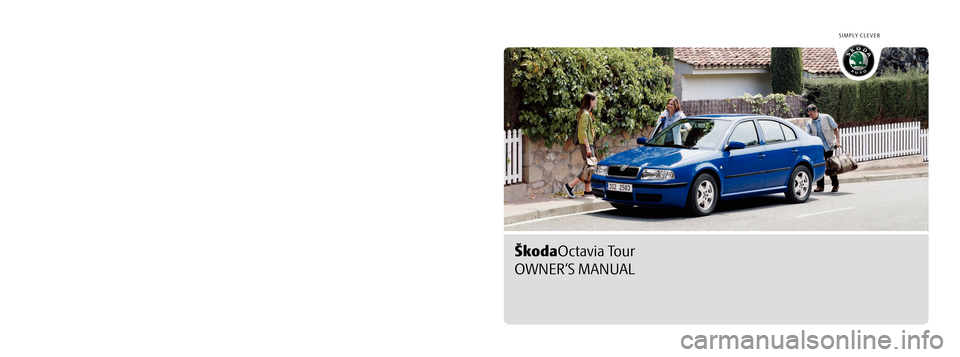
SIMPLY CLEVER
How you can contribute to a cleaner environment
The fuel consumption of your Škoda - and thus the level of
pollutants contained in the exhaust - is also determined by
how you drive.
The noise level and wear and tear are also influenced by how
you personally handle your vehicle. This Owner ´s Manual tells
you how to drive your Škoda to achieve the minimum impact
on the environment, and how to save money at the same time.
Look up „Environment“ in the Index to find out more.
Please also refer to all the texts identified with a
in this
Owner ´s Manual.
Make your contribution - for the sake of the
environment.
www.skoda-auto.com
Návod k obsluze
Octavia Tour anglicky 05.09
S63.5610.34.20
1U0 012 003 KT
Octavia Tour anglicky 05.09S63.5610.34.20
ŠkodaOctavia Tour
OWNER‘S MANUAL
Page 5 of 224
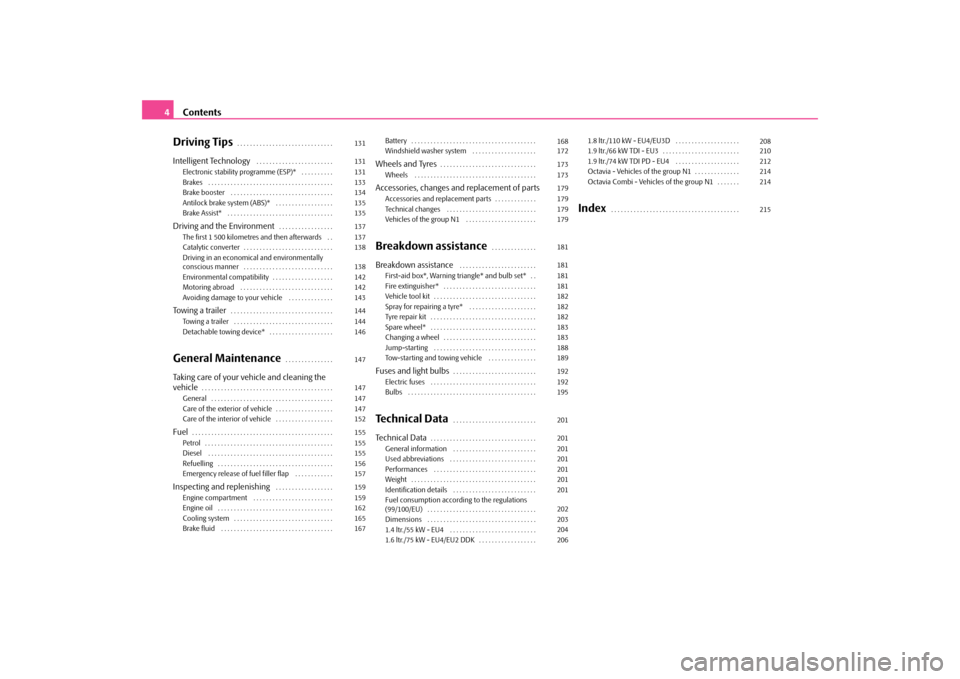
Contents
4Driving Tips
. . . . . . . . . . . . . . . . . . . . . . . . . . . . . .
Intelligent Technology
. . . . . . . . . . . . . . . . . . . . . . . .
Electronic stability programme (ESP)* . . . . . . . . . . Brakes . . . . . . . . . . . . . . . . . . . . . . . . . . . . . . . . . . . . . . . Brake booster . . . . . . . . . . . . . . . . . . . . . . . . . . . . . . . . Antilock brake system (ABS)* . . . . . . . . . . . . . . . . . . Brake Assist* . . . . . . . . . . . . . . . . . . . . . . . . . . . . . . . . . Driving and the Environment
. . . . . . . . . . . . . . . . .
The first 1 500 kilometres and then afterwards . . Catalytic converter . . . . . . . . . . . . . . . . . . . . . . . . . . . . Driving in an economical and environmentally conscious manner . . . . . . . . . . . . . . . . . . . . . . . . . . . . Environmental compatibility . . . . . . . . . . . . . . . . . . . Motoring abroad . . . . . . . . . . . . . . . . . . . . . . . . . . . . . Avoiding damage to your vehicle . . . . . . . . . . . . . . To w i n g a t r a i l e r
. . . . . . . . . . . . . . . . . . . . . . . . . . . . . . . .
Towing a trailer . . . . . . . . . . . . . . . . . . . . . . . . . . . . . . . Detachable towing device* . . . . . . . . . . . . . . . . . . . . General Maintenance
. . . . . . . . . . . . . . .
Taking care of your ve
hicle and cleaning the
vehicle
. . . . . . . . . . . . . . . . . . . . . . . . . . . . . . . . . . . . . . . . .
General . . . . . . . . . . . . . . . . . . . . . . . . . . . . . . . . . . . . . . Care of the exterior of vehicle . . . . . . . . . . . . . . . . . . Care of the interior of vehicle . . . . . . . . . . . . . . . . . . Fuel
. . . . . . . . . . . . . . . . . . . . . . . . . . . . . . . . . . . . . . . . . . . . Petrol . . . . . . . . . . . . . . . . . . . . . . . . . . . . . . . . . . . . . . . . Diesel . . . . . . . . . . . . . . . . . . . . . . . . . . . . . . . . . . . . . . . Refuelling . . . . . . . . . . . . . . . . . . . . . . . . . . . . . . . . . . . . Emergency release of fuel filler flap . . . . . . . . . . . . Inspecting and replenishing
. . . . . . . . . . . . . . . . . .
Engine compartment . . . . . . . . . . . . . . . . . . . . . . . . . Engine oil . . . . . . . . . . . . . . . . . . . . . . . . . . . . . . . . . . . . Cooling system . . . . . . . . . . . . . . . . . . . . . . . . . . . . . . . Brake fluid . . . . . . . . . . . . . . . . . . . . . . . . . . . . . . . . . . .
Battery . . . . . . . . . . . . . . . . . . . . . . . . . . . . . . . . . . . . . . . Windshield washer system . . . . . . . . . . . . . . . . . . . .Wheels and Tyres
. . . . . . . . . . . . . . . . . . . . . . . . . . . . . .
Wheels . . . . . . . . . . . . . . . . . . . . . . . . . . . . . . . . . . . . . .Accessories, changes and replacement of partsAccessories and replacement parts . . . . . . . . . . . . . Technical changes . . . . . . . . . . . . . . . . . . . . . . . . . . . .Vehicles of the group N1 . . . . . . . . . . . . . . . . . . . . . .Breakdown assistance
. . . . . . . . . . . . . .
Breakdown assistance
. . . . . . . . . . . . . . . . . . . . . . . .
First-aid box*, Warning triangle* and bulb set* . . Fire extinguisher* . . . . . . . . . . . . . . . . . . . . . . . . . . . . .Vehicle tool kit . . . . . . . . . . . . . . . . . . . . . . . . . . . . . . . .Spray for repairing a tyre* . . . . . . . . . . . . . . . . . . . . .Tyre repair kit . . . . . . . . . . . . . . . . . . . . . . . . . . . . . . . . .Spare wheel* . . . . . . . . . . . . . . . . . . . . . . . . . . . . . . . . .Changing a wheel . . . . . . . . . . . . . . . . . . . . . . . . . . . . .Jump-starting . . . . . . . . . . . . . . . . . . . . . . . . . . . . . . . .Tow-starting and towing vehicle . . . . . . . . . . . . . . .Fuses and light bulbs
. . . . . . . . . . . . . . . . . . . . . . . . . .
Electric fuses . . . . . . . . . . . . . . . . . . . . . . . . . . . . . . . . . Bulbs . . . . . . . . . . . . . . . . . . . . . . . . . . . . . . . . . . . . . . . .Technical Data
. . . . . . . . . . . . . . . . . . . . . . . . . .
Technical Data
. . . . . . . . . . . . . . . . . . . . . . . . . . . . . . . . .
General information . . . . . . . . . . . . . . . . . . . . . . . . . . Used abbreviations . . . . . . . . . . . . . . . . . . . . . . . . . . .Performances . . . . . . . . . . . . . . . . . . . . . . . . . . . . . . . .Weight . . . . . . . . . . . . . . . . . . . . . . . . . . . . . . . . . . . . . . .Identification details . . . . . . . . . . . . . . . . . . . . . . . . . .Fuel consumption according to the regulations (99/100/EU) . . . . . . . . . . . . . . . . . . . . . . . . . . . . . . . . . . Dimensions . . . . . . . . . . . . . . . . . . . . . . . . . . . . . . . . . .1.4 ltr./55 kW - EU4 . . . . . . . . . . . . . . . . . . . . . . . . . . .1.6 ltr./75 kW - EU4/EU2 DDK . . . . . . . . . . . . . . . . . .
1.8 ltr./110 kW - EU4/EU3D . . . . . . . . . . . . . . . . . . . . 1.9 ltr./66 kW TDI - EU3 . . . . . . . . . . . . . . . . . . . . . . . .1.9 ltr./74 kW TDI PD - EU4 . . . . . . . . . . . . . . . . . . . .Octavia - Vehicles of the group N1 . . . . . . . . . . . . . .Octavia Combi - Vehicles of the group N1 . . . . . . .Index
. . . . . . . . . . . . . . . . . . . . . . . . . . . . . . . . . . . . . . . .
131 131 131 133134135135 137 137 138 138 142142143 144 144 146 147 147 147 147152 155 155 155156157 159 159 162165167
168 172 173 173 179 179 179179 181 181 181 181182182182183183188189 192 192 195 201 201 201 201201201201 202 203204206
208 210 212214214 215
s2g8.b.book Page 4 Tuesday, April 7, 2009 8:53 AM
Page 21 of 224
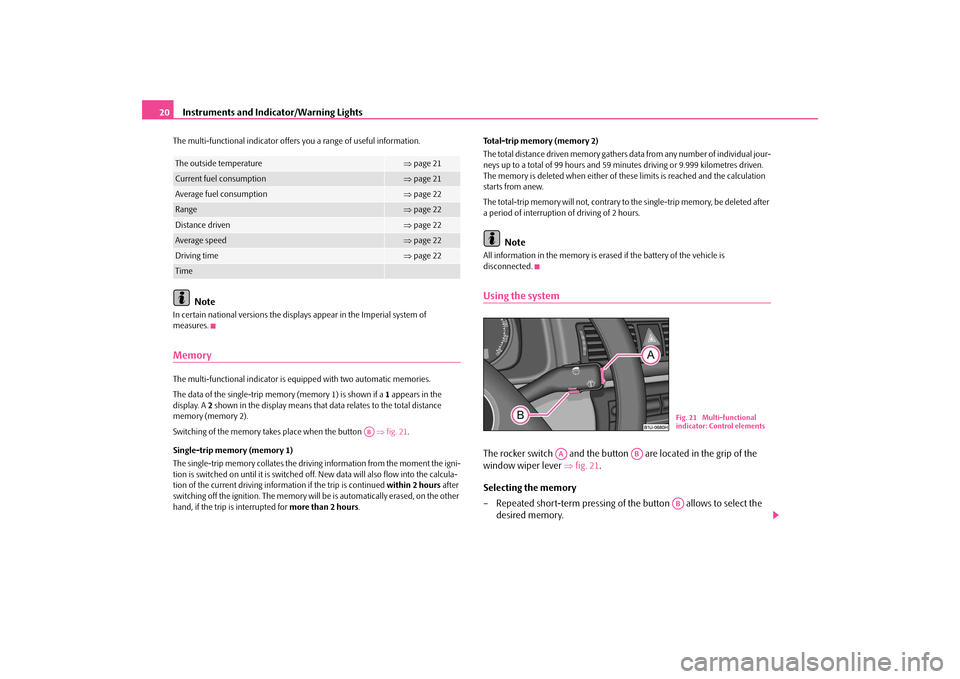
Instruments and Indicator/Warning Lights
20
The multi-functional indicator offers
you a range of useful information.
Note
In certain national versions the displays
appear in the Imperial system of
measures.MemoryThe multi-functional indicator is eq
uipped with two automatic memories.
The data of the single-trip memory (memory 1) is shown if a
1 appears in the
display. A
2 shown in the display means that da
ta relates to the total distance
memory (memory 2). Switching of the memory takes place when the button
⇒fig. 21
.
Single-trip memory (memory 1) The single-trip memory collates the driving information from the moment the igni- tion is switched on until it
is switched off. New data will
also flow into the calcula-
tion of the current driving information if the trip is continued
within 2 hours
after
switching off the ignition. The memory will
be is automatically erased, on the other
hand, if the trip is interrupted for
more than 2 hours
.
Total-trip memory (memory 2) The total distance driven memory gathers
data from any number of individual jour-
neys up to a total of 99 hours and 59 minutes driving or 9.999 kilometres driven. The memory is deleted when either of these limits is reached and the calculation starts from anew. The total-trip memory will not, contrary to
the single-trip memory, be deleted after
a period of interruption of driving of 2 hours.
Note
All information in the memory is erased if the battery of the vehicle is disconnected.Using the systemThe rocker switch and the button are located in the grip of the window wiper lever
⇒
fig. 21
.
Selecting the memory – Repeated short-term pressing of th
e button allows to select the
desired memory.
The outside temperature
⇒ page 21
Current fuel consumption
⇒page 21
Average fuel consumption
⇒page 22
Range
⇒page 22
Distance driven
⇒page 22
Average speed
⇒page 22
Driving time
⇒page 22
Time
AB
Fig. 21 Multi-functional indicator: Control elements
AA
AB
AB
s2g8.b.book Page 20 Tuesday, April 7, 2009 8:53 AM
Page 22 of 224
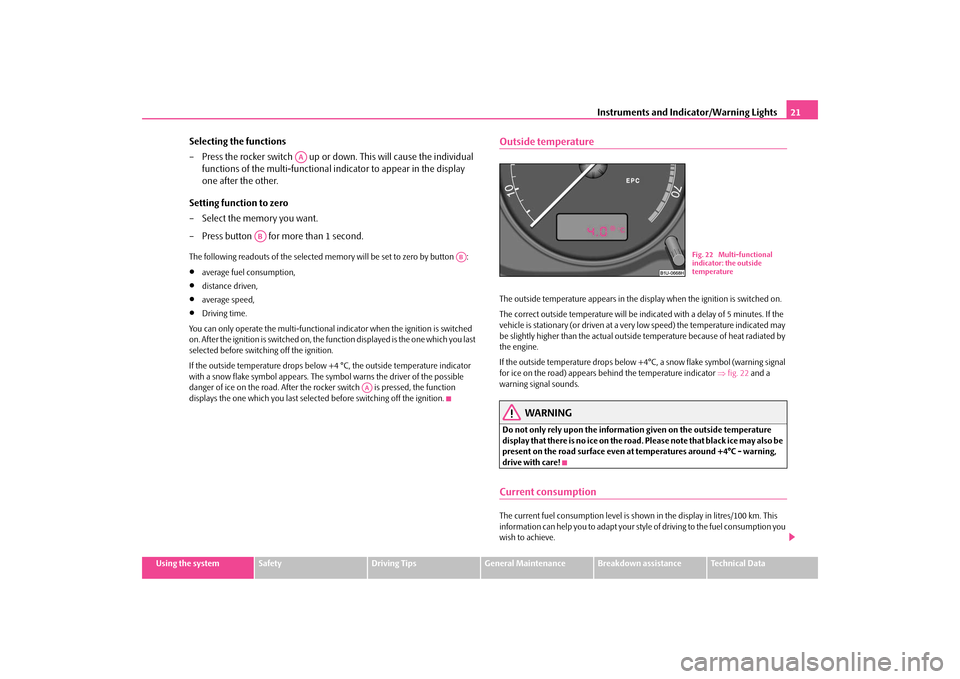
Instruments and Indicator/Warning Lights
21
Using the system
Safety
Driving Tips
General Maintenance
Breakdown assistance
Technical Data
Selecting the functions – Press the rocker switch up or down. This will cause the individual
functions of the multi-f
unctional indicator to
appear in the display
one after the other.
Setting function to zero – Select the memory you want. – Press button for more than 1 second.The following readouts of the selected me
mory will be set to zero by button :
•
average fuel consumption,
•
distance driven,
•
average speed,
•
Driving time.
You can only operate the multi-functional
indicator when the ignition is switched
on. After the ignition is switched on, the fu
nction displayed is the one which you last
selected before switching off the ignition. If the outside temperature drops below
+4 °C, the outside temperature indicator
with a snow flake symbol appears. The symbol warns the driver of the possible danger of ice on the road. After the rock
er switch is pressed, the function
displays the one which you last selected before switching off the ignition.
Outside temperatureThe outside temperature appears in the disp
lay when the ignition is switched on.
The correct outside temperature will be indi
cated with a delay of
5 minutes. If the
vehicle is stationary (or driven at a very low speed) the temperature indicated may be slightly higher than the actual outsid
e temperature because of
heat radiated by
the engine. If the outside temperature drops below +4°C
, a snow flake symbol (warning signal
for ice on the road) appears be
hind the temperature indicator
⇒fig. 22
and a
warning signal sounds.
WARNING
Do not only rely upon the information given on the outside temperature display that there is no ice on the road.
Please note that bl
ack ice may also be
present on the road surface even at
temperatures around +4°C - warning,
drive with care!Current consumptionThe current fuel consumption level is shown in the display in litres/100 km. This information can help you to adapt your styl
e of driving to the fuel consumption you
wish to achieve.
AA
AB
AB
AA
Fig. 22 Multi-functional indicator: the outside temperature
s2g8.b.book Page 21 Tuesday, April 7, 2009 8:53 AM
Page 23 of 224
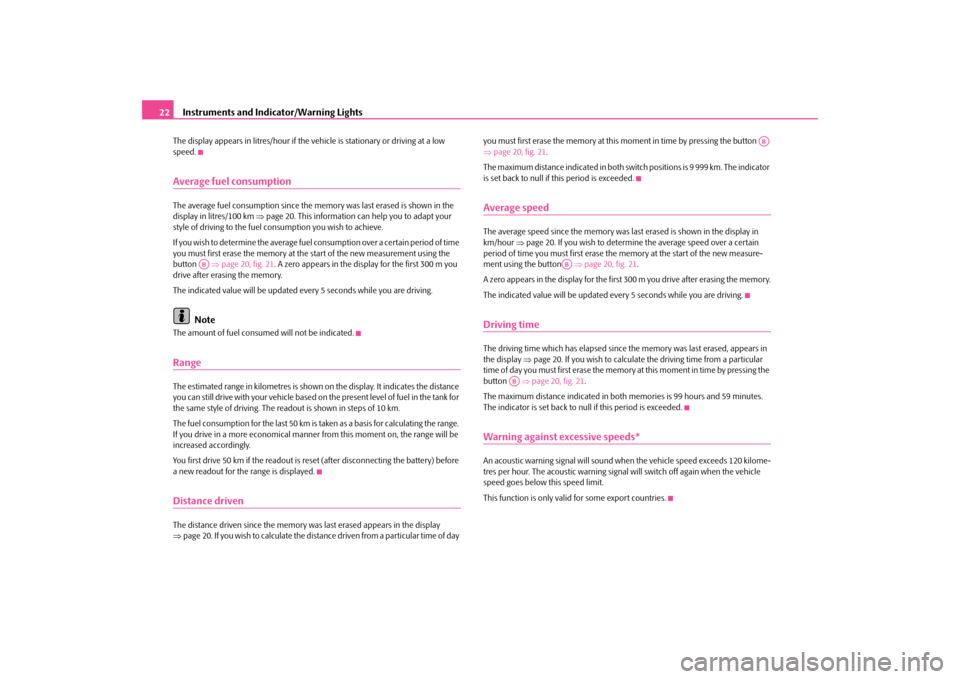
Instruments and Indicator/Warning Lights
22
The display appears in litres/hour if the vehicle is stationary or driving at a low speed.Average fuel consumptionThe average fuel consumption since the memory was last erased is shown in the display in litres/100 km
⇒page 20. This information can help you to adapt your
style of driving to the fuel co
nsumption you wish to achieve.
If you wish to determine the average fuel
consumption over a cert
ain period of time
you must first erase the memory at the start of the new measurement using the button
⇒page 20, fig. 21
. A zero appears in the display for the first 300 m you
drive after erasing the memory. The indicated value will be updated every 5 seconds while you are driving.
Note
The amount of fuel consumed will not be indicated.RangeThe estimated range in kilometres is shown on the display. It indicates the distance you can still drive with your vehicle based on the present level of fuel in the tank for the same style of driving. The readout is shown in steps of 10 km. The fuel consumption for the last 50 km is
taken as a basis for calculating the range.
If you drive in a more economical manner from this moment on, the range will be increased accordingly. You first drive 50 km if the readout is reset (after disconnecting the battery) before a new readout for the range is displayed.Distance drivenThe distance driven since the memory was last erased appears in the display ⇒ page 20. If you wish to calculate the distance driven from a particular time of day
you must first erase the memory at this mo
ment in time by pressing the button
⇒ page 20, fig. 21
.
The maximum distance indicated in both sw
itch positions is 9 999 km. The indicator
is set back to null if th
is period is exceeded.
Average speedThe average speed since the memory was last erased is shown in the display in km/hour
⇒page 20. If you wish to determine
the average speed over a certain
period of time you must first erase the memory at the start of the new measure- ment using the button
⇒page 20, fig. 21
.
A zero appears in the display for the first 300 m you drive after erasing the memory.The indicated value will be updated every 5 seconds while you are driving.Driving timeThe driving time which has elapsed since the memory was last erased, appears in the display
⇒page 20. If you wish to calculate th
e driving time from a particular
time of day you must first erase the memory at this moment in time by pressing the button
⇒page 20, fig. 21
.
The maximum distance indi
cated in both memories is 99 hours and 59 minutes.
The indicator is set back to null
if this period is exceeded.
Warning against excessive speeds*An acoustic warning signal will sound
when the vehicle speed exceeds 120 kilome-
tres per hour. The acoustic warning signal
will switch off again when the vehicle
speed goes below this speed limit. This function is only vali
d for some export countries.
AB
AB
AB
AB
s2g8.b.book Page 22 Tuesday, April 7, 2009 8:53 AM
Page 56 of 224
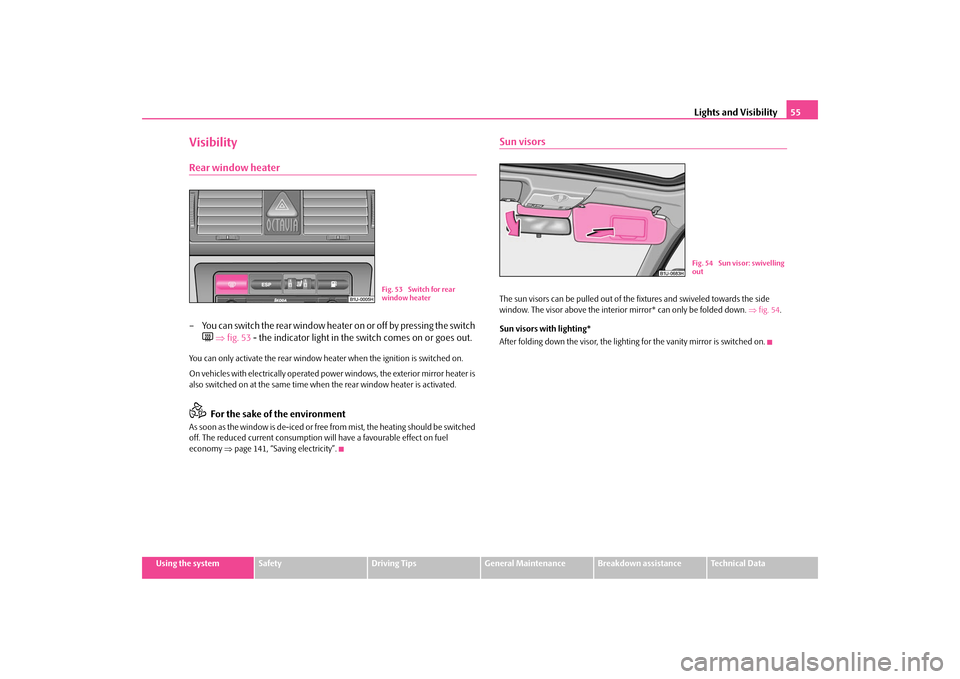
Lights and Visibility
55
Using the system
Safety
Driving Tips
General Maintenance
Breakdown assistance
Technical Data
VisibilityRear window heater– You can switch the rear window heater on or off by pressing the switch
⇒
fig. 53
- the indicator light in the
switch comes on or goes out.
You can only activate the rear window he
ater when the ignition is switched on.
On vehicles with electrically operated power windows, the exterior mirror heater is also switched on at the same time when
the rear window heater is activated.
For the sake of the environment
As soon as the window is de-iced or free from mist, the heating should be switched off. The reduced current consumption will have a favourable effect on fuel economy
⇒page 141, “Saving electricity”.
Sun visorsThe sun visors can be pulled out of the fixtures and swiveled towards the side window. The visor above the interior mirror* can only be folded down.
⇒fig. 54
.
Sun visors with lighting* After folding down the visor, the lighting for the vanity mirror is switched on.
Fig. 53 Switch for rear window heater
Fig. 54 Sun visor: swivelling out
s2g8.b.book Page 55 Tuesday, April 7, 2009 8:53 AM
Page 76 of 224
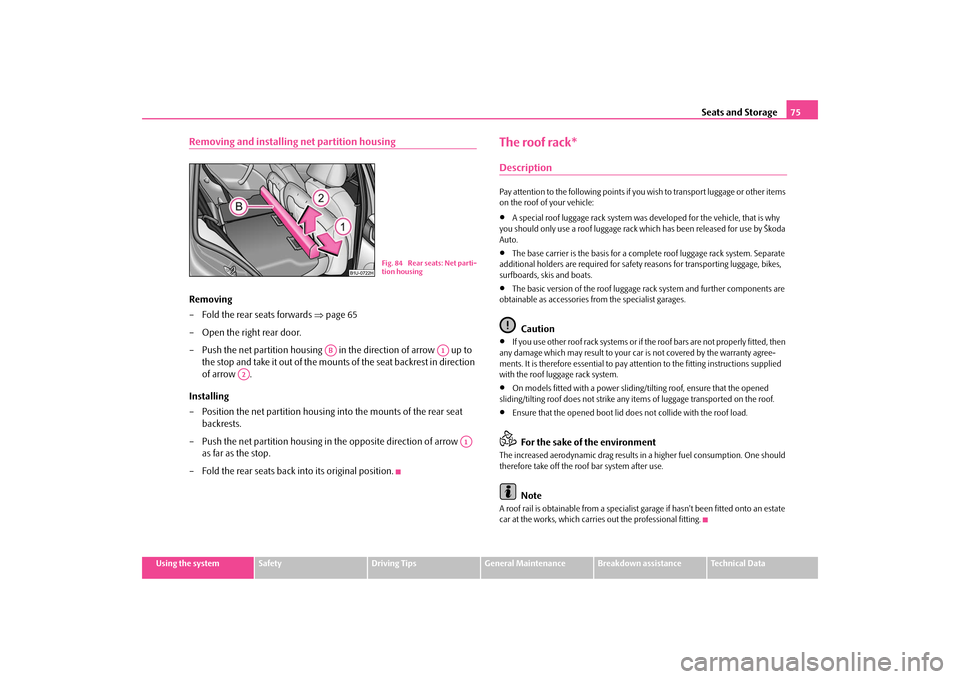
Seats and Storage
75
Using the system
Safety
Driving Tips
General Maintenance
Breakdown assistance
Technical Data
Removing and installing net partition housingRemoving – Fold the rear seats forwards
⇒
page 65
– Open the right rear door. – Push the net partition housing in the direction of arrow up to
the stop and take it out of the mounts
of the seat backrest in direction
of arrow .
Installing – Position the net partition housing into the mounts of the rear seat
backrests.
– Push the net partition housing in the opposite direction of arrow
as far as the stop.
– Fold the rear seats back into its original position.
The roof rack*DescriptionPay attention to the following points if yo
u wish to transport luggage or other items
on the roof of your vehicle:•
A special roof luggage rack system was
developed for the vehicle, that is why
you should only use a roof luggage rack
which has been released for use by Škoda
Auto.•
The base carrier is the basis for a comple
te roof luggage rack system. Separate
additional holders are required for safety reasons for transporting luggage, bikes, surfboards, skis and boats.•
The basic version of the roof luggage rack system and further components are
obtainable as accessories from the specialist garages.
Caution
•
If you use other roof rack sy
stems or if the roof bars are not properly fitted, then
any damage which may result to your ca
r is not covered by the warranty agree-
ments. It is therefore essential to pay attention to the fitting instructions supplied with the roof luggage rack system.•
On models fitted with a power sliding/tilting roof, ensure that the opened
sliding/tilting roof does not strike any items of luggage transported on the roof.•
Ensure that the opened boot lid does not collide with the roof load.For the sake of the environment
The increased aerodynamic drag results in
a higher fuel consumption. One should
therefore take off the roof bar system after use.
Note
A roof rail is obtainable from a specialist garage if hasn't been fitted onto an estate car at the works, which carries
out the professional fitting.
Fig. 84 Rear seats: Net parti- tion housing
AB
A1
A2
A1
s2g8.b.book Page 75 Tuesday, April 7, 2009 8:53 AM
Page 89 of 224
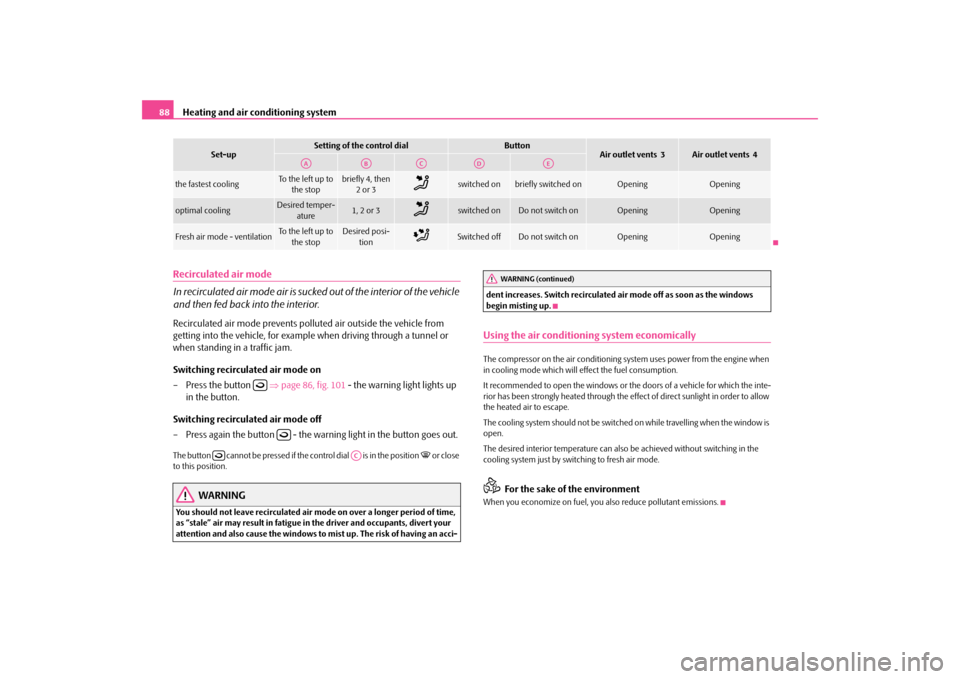
Heating and air conditioning system
88
Recirculated air mode In recirculated air mode air is sucked
out of the interior of the vehicle
and then fed back into the interior.Recirculated air mode prevents polluted air outside the vehicle from getting into the vehicle, for example when driving through a tunnel or when standing in a traffic jam. Switching recirculated air mode on – Press the button
⇒
page 86, fig. 101
- the warning light lights up
in the button.
Switching recirculated air mode off – Press again the button - the warning light in the button goes out.The button cannot be pressed if the control dial is in the position
or close
to this position.
WARNING
You should not leave recirculated air mode on over a longer period of time, as “stale” air may result in fatigue in the driver and occupants, divert your attention and also cause the windows to mist up. The risk of having an acci-
dent increases. Switch recirculated air mode off as soon as the windows begin misting up.Using the air conditioning system economicallyThe compressor on the air co
nditioning system uses po
wer from the engine when
in cooling mode which will effect the fuel consumption. It recommended to open the windows or the doors of a vehicle for which the inte- rior has been strongly heated through the ef
fect of direct sunlight in order to allow
the heated air to escape. The cooling system should not be switched on while travelling when the window is open. The desired interior temperature can also be achieved without switching in the cooling system just by switching to fresh air mode.
For the sake of the environment
When you economize on fuel, you also reduce pollutant emissions.
the fastest cooling
To the left up to
the stop
briefly 4, then
2or 3
switched on
briefly switched on
Opening
Opening
optimal cooling
Desired temper-
ature
1, 2 or 3
switched on
Do not switch on
Opening
Opening
Fresh air mode - ventilation
To the left up to
the stop
Desired posi-
tion
Switched off
Do not switch on
Opening
Opening
Set-up
Setting of the control dial
Button
Air outlet vents 3
Air outlet vents 4
AA
AB
AC
AD
AE
AC
WARNING (continued)
s2g8.b.book Page 88 Tuesday, April 7, 2009 8:53 AM
Page 95 of 224
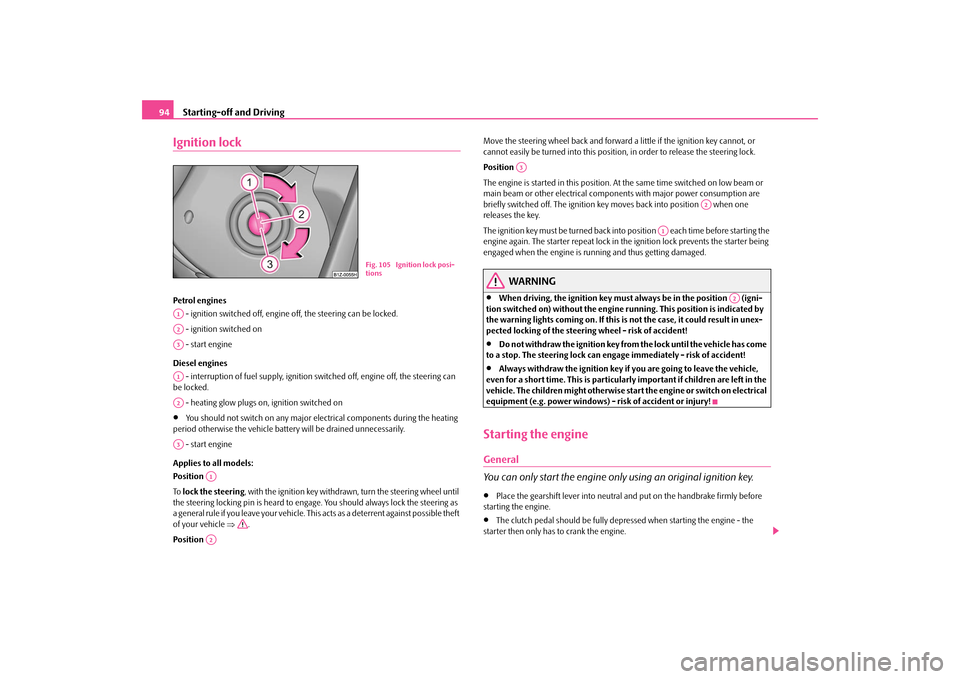
Starting-off and Driving
94
Ignition lockPetrol engines - ignition switched off, engine
off, the steering can be locked.
- ignition switched on - start engine Diesel engines - interruption of fuel supply, ignition sw
itched off, engine off, the steering can
be locked. - heating glow plugs on, ignition switched on•
You should not switch on any major elec
trical components during the heating
period otherwise the vehicle batt
ery will be drained unnecessarily.
- start engine Applies to all models: Position
To lock the steering
, with the ignition key withdrawn, turn the steering wheel until
the steering locking pin is heard to engage. You should always lock the steering as a general rule if you leave your
vehicle. This acts as a deterrent against possible theft
of your vehicle
⇒
.
Position
Move the steering wheel back and forward a little if the ignition key cannot, or cannot easily be turned into
this position, in order to
release the steering lock.
Position
The engine is started in this position. At
the same time switched on low beam or
main beam or other electrical compon
ents with major power consumption are
briefly switched off. The ignition key
moves back into position when one
releases the key. The ignition key must be turned back into position each time before starting the engine again. The starter repeat lock in th
e ignition lock prevents the starter being
engaged when the engine is r
unning and thus getting damaged.
WARNING
•
When driving, the ignition key must always be in the position (igni-
tion switched on) without the engine running. This position is indicated by the warning lights coming on. If this is not the case, it could result in unex- pected locking of the steerin
g wheel - risk of accident!
•
Do not withdraw the ignition key from the lock until the vehicle has come
to a stop. The steering lock can en
gage immediately - risk of accident!
•
Always withdraw the ignition key if
you are going to leave the vehicle,
even for a short time. This is particularly important if children are left in the vehicle. The children might
otherwise start the engine
or switch on electrical
equipment (e.g. power windows) - risk of accident or injury!Starting the engineGeneral You can only start the engine only using an original ignition key.•
Place the gearshift lever into neutral an
d put on the handbrake firmly before
starting the engine.•
The clutch pedal should be fully depr
essed when starting the engine - the
starter then only has to crank the engine.
Fig. 105 Ignition lock posi- tions
A1A2A3A1A2A3
A1A2
A3
A2
A1
A2
s2g8.b.book Page 94 Tuesday, April 7, 2009 8:53 AM
Page 138 of 224

Driving and the Environment
137
Using the system
Safety
Driving Tips
General Maintenance
Breakdown assistance
Technical Data
Driving and the EnvironmentThe first 1 500 kilometres and then afterwardsA new engine The engine has to be run in during the first 1 500 kilometres.Up to 1 000 kilometres – Do not drive faster than 3/4 of the
maximum speed of the gear in use,
that is 3/4 of the maximum permissible engine speed.
– Do not use full throttle.– Avoid high engine revolutions. – Do not tow a trailer. From 1 000 up to 1 500 kilometres – Increase the power output of the engine
gradually
up to the full
speed of the gear engaged, that
is up to the maximum permissible
engine revolutions.
During the first operating hours the engine
has higher internal
friction than later
until all of the moving parts have harmonized. The driving style which you adopt during the first approx.1 500 kilometres
plays a decisive part in the success of
running in yo
ur vehicle.
You should not drive at unnecessarily
high engine revolutions
even after the
running-in period is
complete. The maximum permissib
le engine spee
d is marked
by the beginning of the red zone on the scale of the revolutions counter. Shift up into the next higher gear on a vehicle
fitted with manual gearbox before the red
zone is reached.
Extremely
high engine revolutions are automatically governed, by
the way. For a vehicle fitted with a manual gearbox
the converse situation also applies: Do
not drive at engine revolutions which are
too low
. Shift down as soon as the engine
is no longer running smoothly.
Caution
All the speed and engine revolution figure
s apply only when the engine is at its
normal operating temperature. Never rev up
an engine which is cold, neither when
the vehicle is stationary nor when driving in individual gears.
For the sake of the environment
Not driving at unnecessarily high engine revolutions and shifting to a higher gear as early as possible are ways to minimise fuel consumption and operating noise levels and protects the environment.New tyresNew tyres have to be “run in” since they do
not offer optimal grip at first. You should
take account of this fact for the first 500 kilometres and drive particularly carefully.New brake padsAllow for the fact that new brake pads do
not achieve their full braking efficiency
until approximately 200 kilometres. New brake pads must be first “run in” before they develop their optimal friction force.
You can, however, compensate for this
slightly reduced braking force by increasing the pressure on the brake pedal. This guideline also applies to any new
brake pads installed at a future date.
During the running-in period, you should
avoid excessive stresses on the brakes.
This includes, for example, violent braking,
particularly from very high speeds, and
also when crossing mountain passes.
s2g8.b.book Page 137 Tuesday, April 7, 2009 8:53 AM